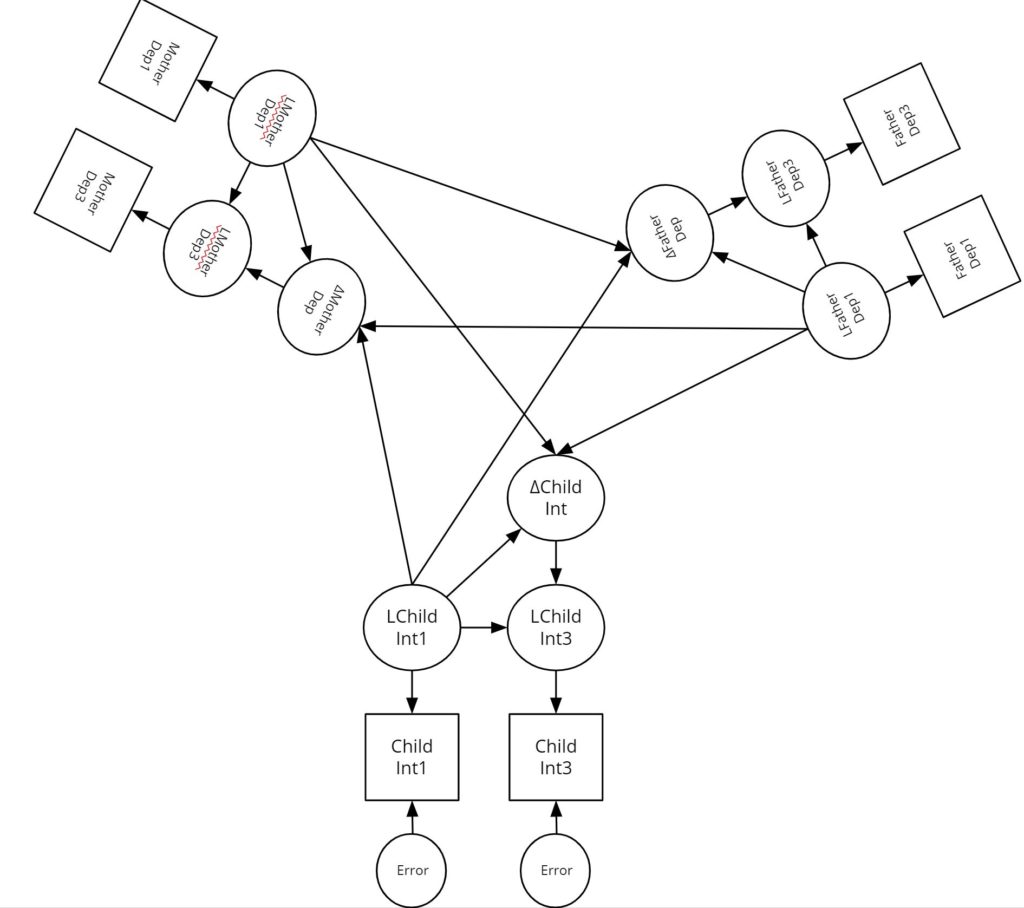For more information on this presentation contact Emily Bailey (Emily.Nicole.Bailey@live.mercer.edu). For more information on the trivariate latent difference score contact Craig Marker (marker_cd@mercer.edu).
Parental Psychological Distress Interacting to Influence Child Internalizing Behaviors Presented at the 2019 WCBCT Conference in Berlin, Germany
References
Almeida, D.M., Wethington, E., Chandler, A.L. (1999). Daily transmission of tensions between marital dyads and parent-child dyads. Journal of Marriage and Family, 61(1), 46-61. doi:10.2307/353882.
Bögels, S.M., & Brechman-Toussaint, M. (2006). Family issues in child anxiety: Attachment, family functioning, paternal rearing and beliefs. Clinical Psychology Review, 7, 834-856
Connell, A. M., & Goodman, S. H. (2002). The association between psychopathology in fathers versus mothers and children’s internalizing and externalizing behavior problems: A meta-analysis. Psychological Bulletin, 128(5), 746-773. doi:10.1037/0033- 2909.128.5.746
Cummings, M., Davies, P.T., & Campbell, S.B. (2001). Understanding the impact of marital conflict on children. Brown University Child & Adolescent Behavior Letter, 17(5).
Fletcher, A.C., & Johnston, C.A. (2016). Parenting behaviors and child externalizing: A short term investigation of directionality. Journal of Child and Family Studies, 25, 3150-3159. doi:10.1007/s10826-016-0467-9.
Goodman, C.R. & Shippy, R. A. (2002). Is it contagious? Affect similarity among spouses. Aging & Mental Health, 6(3), 266-274. doi:10.1080/1360786022914231
Hanington, L., Heron, J., Stein, A., Ramchandani, P. (2012). Parental depression and child outcomes- is marital conflict the missing link? Child Care and Health Development, 38 (4), 520-529. doi: 10.1111/j.1365-2214.2011.01270.x
Kerr, M.E., & Bowen, M. (1988). Family evaluation: An approach based on Bowen theory. New York: Norton.
Klasen, F., Otto, C., Kriston, L., Patalay, P., Schlack, R., & Ravens-Sieberer, U. (2015). Risk and protective factors for the development of depressive symptoms in children and adolescents: Results of the longitudinal BELLA study. European Child & Adolescent Psychiatry, 24(6), 695-703. doi:10.1007/s00787-014-0637-5
McArdle, J.J., & Hamagami, F. (2001). Latent difference score structural models for linear dynamic analyses with incomplete longitudinal data. In L. Collins (Ed.), New methods for the analysis of change: Decades of behavior (pp. 139-175). Washington, DC: American Psychological Association
Merikangas, K., He, J-P., Burstein, M., Swanson, S.A., Avenevoli, S., Cui, L., Georgiades, K., & Swendsen, J. (2010). Lifetime prevalence of mental disorders in US adolescents: Results for the National Comorbidity Study-Adolescent Supplement (NCS-A). Journal of the American Academy of Child and Adolescent Psychiatry, 49 (10).
Möller, E.L., Majdandžić, M., Bögels, S.M. (2015). Parental anxiety, parenting behavior, and infant anxiety: Differential associations for fathers and mothers. Journal of Child and Family Studies, 24 (9), 2626-2637. doi:10.1007/s10826-014-0065-7
National Alliance on Mental Illness (n.d.). Mental health by the numbers. Retrieved from: https://www.nami.org/learn-more/mental-health-by-the-numbers
Phares, V., & Compas, B. E. (1992). The role of fathers in child and adolescent psychopathology: Make room for daddy. Psychological Bulletin, 111(3), 387-412. doi:10.1037/0033-2909.111.3.387
Tavassolie, T., Dudding, S., Madigan A.L., Thorvardarson, E., & Winsler, A. (2016). Differences in perceived parenting style between mothers and fathers: Implications for child outcome and marital conflict. Journal of Child and Family Studies, 25, 2055-2068. doi: 10.1007/s10826-016-0376-y
Van der Pol, L.D., Groeneveld, N.G., Endendijk, J.J., van Berkel, S.R., Hallers-Haalboom, E.T., Bakermans-Kranenburg, M.J., & Mesman, J. (2016). Associations between fathers’ and mothers’ psychopathology symptoms, parental emotion socialization, and preschoolers’ social-emotional development. Journal of Child and Family Studies, 25, 3367-3380. doi: 10.1007/s10826-016-0490-x.
